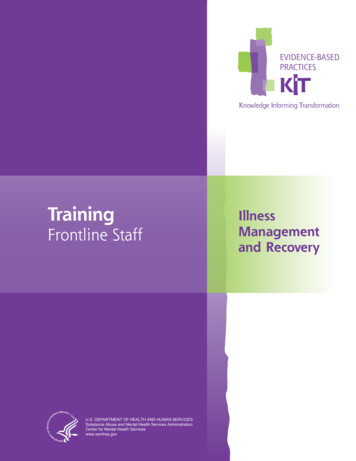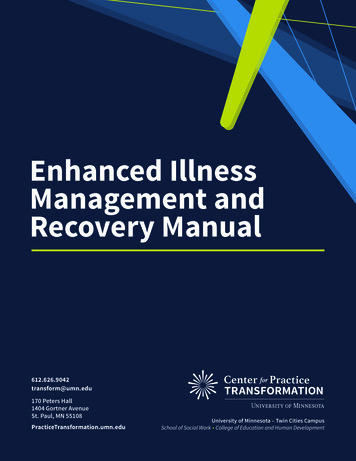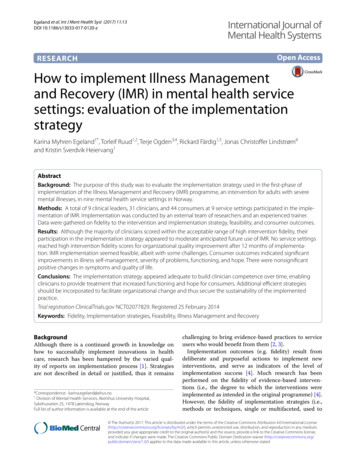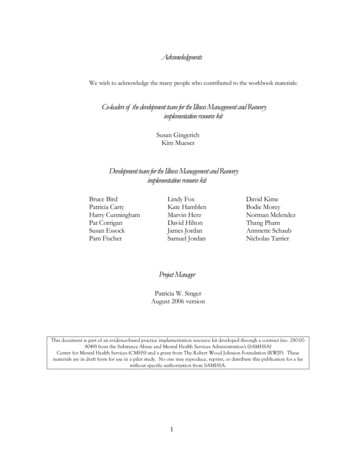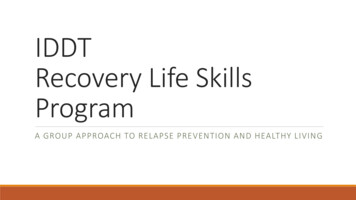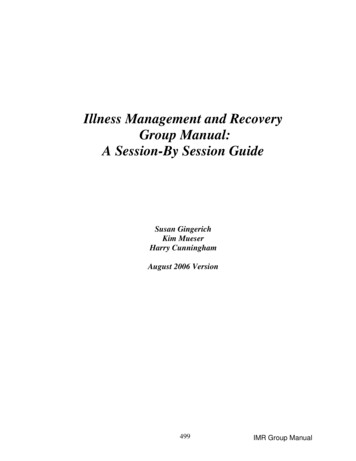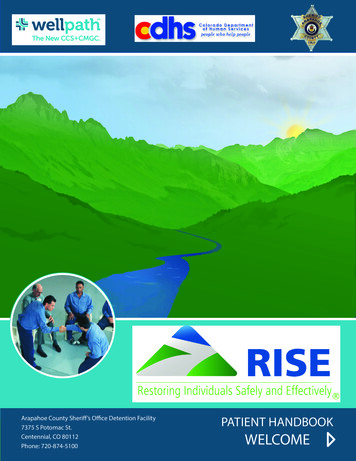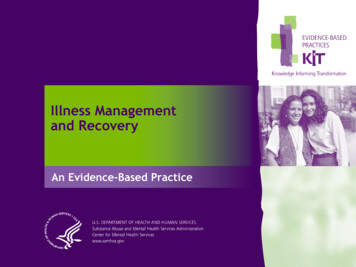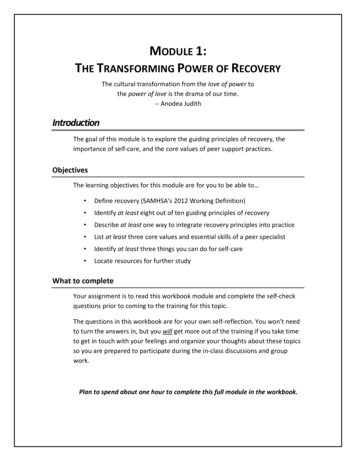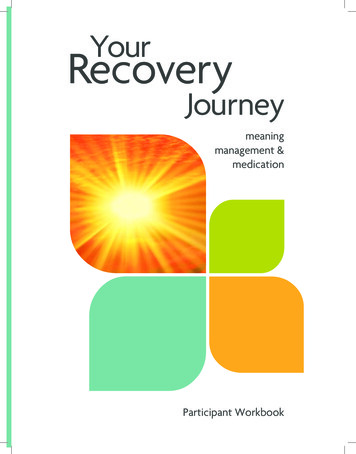
Transcription
PractitionerGuides and HandoutsU.S. DEPARTMENT OF HEALTH AND HUMAN SERVICESSubstance Abuse and Mental Health Services AdministrationCenter for Mental Health Serviceswww.samhsa.govIllnessManagementand Recovery
PractitionerGuides and HandoutsU.S. Department of Health and Human ServicesSubstance Abuse and Mental Health Services AdministrationCenter for Mental Health ServicesIllnessManagementand Recovery
AcknowledgmentsThis document was prepared for the Substance Abuse and Mental Health Services Administration(SAMHSA) by the New Hampshire-Dartmouth Psychiatric Research Center under contract number280-00-8049 and Westat under contract number 270-03-6005, with SAMHSA, U.S. Departmentof Health and Human Services (HHS). Pamela Fischer, Ph.D. and Crystal Blyler, Ph.D. served asSAMHSA Government Project Officers.DisclaimerThe views, opinions, and content of this publication are those of the authors and contributors anddo not necessarily reflect the views, opinions, or policies of the Center for Mental Health Services(CMHS), SAMHSA, or HHS.Public Domain NoticeAll material appearing in this document is in the public domain and may be reproducedor copied without permission from SAMHSA. Citation of the source is appreciated. However,this publication may not be reproduced or distributed for a fee without the specific, writtenauthorization from the Office of Communications, SAMHSA, HHS.Electronic Access and Copies of PublicationThis publication may be downloaded or ordered at http://www.samhsa.gov/shin. Or, pleasecall SAMHSA’s Health Information Network at 1-877-SAMHSA-7 (1-877-726-4727) (Englishand Español).Recommended CitationSubstance Abuse and Mental Health Services Administration. Illness Management and Recovery:Practitioner Guides and Handouts. HHS Pub. No. SMA-09-4462, Rockville, MD: Center for MentalHealth Services, Substance Abuse and Mental Health Services Administration, U.S. Departmentof Health and Human Services, 2009.Originating OfficeCenter for Mental Health ServicesSubstance Abuse and Mental Health Services Administration1 Choke Cherry RoadRockville, MD 20857HHS Publication No. SMA-09-4462Printed 2009
Practitioner Guides and HandoutsPractitioner Guides and Handouts has been developed to guideyour work with the IMR curriculum. Used with the maindocument, Training Frontline Staff, this booklet has all thePractitioner Guides and Handouts that you will use every dayas you implement your Illness Management and Recovery(IMR) program. The IMR curriculum consists of an orientationto the IMR program and these 10 topics:n Recovery strategies;n Practical facts about mental illnesses;n Stress-Vulnerability Model and treatment strategies;n Building social support;n Using medication effectively;n Drug and alcohol use;n Reducing relapses;n Coping with stress;n Coping with problems and persistent symptoms; andn Getting your needs met by the mental health system.For references, see the booklet The Evidence.IllnessManagementand Recovery
This KIT is part of a series of Evidence-Based Practices KITs createdby the Center for Mental Health Services, Substance Abuse andMental Health Services Administration, U.S. Department of Healthand Human Services.This booklet is part of the Illness Management and Recovery KITthat includes a DVD, CD-ROM, and seven booklets:How to Use the Evidence-Based Practices KITsGetting Started with Evidence-Based PracticesBuilding Your ProgramTraining Frontline StaffEvaluating Your ProgramThe EvidenceUsing Multimedia to Introduce Your EBP
What’s in Training Frontline Staff—Practitioner Guides and HandoutsOrientation to Illness Management and Recovery. . . . . . . . . . 3Topic 1:Recovery Strategies . . . . . . . . . . . . . . . . . . . . . . . 7Topic 2:Practical Facts About Mental Illnesses . . . . . . . . . 34Topic 2a: Practical Facts About Schizophrenia. . . . . . . . . . . 66Topic 2b: Practical Facts About Bipolar Disorder. . . . . . . . . 76Topic 2c: Practical Facts About Depression. . . . . . . . . . . . . 84Topic 2d: Strategies and Resourcesfor Responding to Stigma. . . . . . . . . . . . . . . . . . 91Topic 3:The Stress-Vulnerability Modeland Treatment Strategies . . . . . . . . . . . . . . . . . . 95Topic 4:Building Social Supports. . . . . . . . . . . . . . . . . . 117Topic 5:Using Medication Effectively. . . . . . . . . . . . . . 152Topic 5a: Antipsychotic Medications . . . . . . . . . . . . . . . . 182Topic 5b: Mood-Stabilizing Medications. . . . . . . . . . . . . . 184IllnessManagementand Recovery
Topic 5c: Antidepressant Medications . . . . . . . . . . . . . . . 186Topic 5d: Antianxiety and Sedative Medications. . . . . . . . 188Topic 5e: Coping with Side Effects. . . . . . . . . . . . . . . . . . 190Topic 6:Drug and Alcohol Use . . . . . . . . . . . . . . . . . . . 192Topic 7:Reducing Relapses. . . . . . . . . . . . . . . . . . . . . . 229Topic 8:Coping with Stress. . . . . . . . . . . . . . . . . . . . . . 257Topic 8a: Relaxation Techniques . . . . . . . . . . . . . . . . . . . 285Topic 9:Coping with Problemsand Persistent Symptoms. . . . . . . . . . . . . . . . . 288Topic 10: Getting Your Needs Metby the Mental Health System. . . . . . . . . . . . . . 330
Training Frontline StaffPractitioner Guides and HandoutsPractitioner Guides and Handouts areavailable for each topic. The Handoutshave practical information and skills thatconsumers can use in their recoveryprocess. The Handouts are written insimple, easy-to-understand language andinclude informative text, summary boxes,probing questions, and exercises to helpconsumers learn the material in a numberof different ways. They are not meantto be stand-alone documents. Helpconsumers integrate the knowledgeand skills presented in them.Practitioner Guides for each topic weredeveloped to help you provide effectiveIMR services. The guides give you a quickreview of each topic’s overall goal and therecommended structure for every session.Training Frontline Staff1The guides also give you reminders andrecommendations such as the following: Alert you to upcoming exercises so thatyou may allot time to complete them; Prompt you to connect informationwithin the Handout with consumers’personal recovery goals; and Suggest homework assignments thatappropriately reinforce knowledgeand skills.Practitioner Guides also includesuggestions for motivational, educational,and cognitive-behavioral strategies thatare tailored to the topic area. For moreinformation about how to provide IMRservices, see Training Frontline Staff.Practitioner Guides and Handouts
Since you may offer IMR services in an individualformat, a group format, or both, many PractitionerGuides and Handouts have been tailored to theformat in which they will be provided. For thisreason, each Practitioner Guide and Handout ismarked with one of the following icons on the topright corner of the page to identify whether it wasdeveloped for the individual or group format:If a Practitioner Guide or Handout may be usedin either format, both icons will appear. Multiplesessions may be needed to cover a specific topicin the group format. In this case, you will finda Practitioner Guide for each session.Before each session, select and review theappropriate Practitioner Guide and Handoutfor the topic that you will be discussing. Use thismaterial to help comprehensively cover the topicsin the IMR curriculum.Individual sessionGroup sessionPractitioner Guides and Handouts2Training Frontline Staff
Illness Management and Recovery (IMR)Practitioner GuideOrientation to Illness Management and RecoveryIntroductionWhether IMR is offered in an individual or group format, orient consumers to the IMRprogram individually. In orientation sessions, IMR practitioners introduce consumers tothe IMR program, get to know them better, and assess their knowledge and skill levels.Goals Help consumers understand the structure and content of the IMR program. Help consumers understand their role in participating in IMR. Define common expectations for IMR participation. Assess consumers’ knowledge and skill level.HandoutsReview and distribute the IMR Handout—Orientation to Illness Management Recovery(for both individual and group sessions).Number and pacingof sessionsThis topic can usually be covered in one to three sessions.Strategies to be usedin each session Motivational strategies Educational strategies Cognitive-behavioral strategiesMotivational strategiesMotivational strategies used while orienting consumers to the IMR program includehelping consumers identify the benefits of participating and how the overall goals ofIMR apply in their lives.While assessing consumers’ knowledge of mental illnesses and skills for managingtheir illnesses, re-frame past challenges to show that the strategies they used tocope with these difficulties reflect personal strength. Acknowledge past problems ordisappointments and express empathy, but help consumers focus on the future andwhat they might accomplish.Practitioner Guide3Orientation to Illness Management and Recovery
Illness Management and Recovery (IMR)Practitioner GuideOrientation to Illness Management and RecoveryEducational strategiesEducational strategies for this topic help consumers learn about the IMR program.The following educational strategies may be helpful:n Review the Handout by summarizing the main points or taking turns readingthem aloud.n Pause at the end of each section to check for understanding and to learnmore about the consumers’ points of view.n Allow plenty of time for interaction. Make the communication two-way.You are both learning something from each other. It is important not to askquestions too quickly, which consumers may experience as an interrogation.n Allow time to complete the exercises. Some consumers will not need anyhelp completing them. Others may appreciate assistance such as reading words,spelling, or writing some of their answers. Encourage consumers to discuss theiranswers.n Break the content into manageable pieces. It is important not to covermore than consumers can absorb. Present information in small chunks at acomfortable pace.n Use the questions at the end of this Practitioner Guide to assess how wellconsumers understand the main points from this topic.Once consumers decide to participate in the IMR program, give them an IMRbinder that they should bring to every session to store Handouts distributed duringthe ehavioral strategies focus on helping consumers learn how to use theinformation in this session.n Complete the Knowledge and Skills Inventory. Not every question hasto be answered. For more information, see Module 2 in Training Frontline Staff.n Help consumers make connections about how the IMR program can helpthem to achieve their personal recovery goals.Practitioner Guide4Orientation to Illness Management and Recovery
Individual sessionGroup sessionIllness Management and Recovery (IMR)Practitioner GuideOrientation to Illness Management and RecoveryReview questions: Use the following questions to review the main points of this topic. Are you interested in the IMR program? Which part of IMR seems most interesting to you? How do you think the IMR program can help you? If you decide to participate in IMR, what will you have to do?Practitioner Guide5Orientation to Illness Management and Recovery
Individual sessionGroup sessionIllness Management and Recovery (IMR)HandoutOrientation to Illness Management and RecoveryThe overall goals of IMR are to—n Learn about mental illnesses and strategies for treatment;n Decrease symptoms;n Reduce relapses and rehospitalizations; andn Make progress toward goals and toward recovery.IMR practitioners will—n Work side by side with you to help you move forward in your recovery process; andn Provide information, strategies, and skills that can help you manage psychiatricsymptoms and make progress toward your goals.IMR includes—n An orientation session to review the goals and expectations of the program;n One or two sessions to get to know you better;n Three to 10 months of weekly or biweekly sessions;n Active practice of relapse prevention and recovery skills; andn Optional involvement of significant others (family members, friends, practitioners,other supporters) to increase their understanding and support.By participating in IMR, you agree to—n Work side by side with the IMR practitioner to move forward in the recovery process;n Learn about mental illnesses and principles of treatment;n Learn and practice skills for preventing relapses and coping with symptoms; andn Participate in assignments to practice strategies and skills outside of the sessions.Throughout the IMR program, you and the IMR practitioner will strive for—n An atmosphere of hope and optimism;n Regular attendance;n Side-by-side collaboration; andn Making progress toward achieving your goals.Handout6Orientation to Illness Management and Recovery
Individual sessionIllness Management and Recovery (IMR)Practitioner GuideTopic 1: Recovery StrategiesIntroductionThis topic sets a positive and optimistic tone that is continued throughout the IllnessManagement and Recovery (IMR) Program. It conveys confidence that people whoexperience psychiatric symptoms can move forward in their lives. It introduces theconcept of recovery and encourages consumers to develop their own definitions ofrecovery. In these sessions, IMR practitioners help consumers establish personallymeaningful goals that will be followed up throughout the program.Goals Increase consumers’ awareness of the concept of recovery and expand thepossibilities of recovery in their own lives. Identify personal recovery goals. Develop a specific plan for achieving one or two personal recovery goals.HandoutsReview and distribute IMR Handout—Topic 1: Recovery Strategies (for both individualand group sessions).Number and pacingof sessionsThis topic can usually be covered in two to four sessions. For each session, most IMRpractitioners find that covering one or two topics and completing an exercise is acomfortable amount.Structure of the sessions Socialize informally and identify any major problems. Review the previous session. Discuss the homework from the previous session. Praise all efforts and problemsolve obstacles to completing homework. Set goals or follow up on goals. Set the agenda for today’s session. Teach new material (or review material from the previous session, if necessary). Summarize progress made in the current session. Agree on homework to be completed before the next session.Strategies to be used ineach session Motivational strategies Educational strategies Cognitive-behavioral strategiesPractitioner Guide7Topic 1: Recovery Strategies
Illness Management and Recovery (IMR)Practitioner GuideTopic 1: Recovery StrategiesMotivational strategiesMotivational strategies for this topic focus on helping consumers identify the benefitsof moving toward recovery and develop the confidence that they can achieve recoverygoals.Some consumers immediately embrace the concept of recovery. Others are morehesitant and need to be encouraged to realize that pursuing recovery is worth theeffort. Help consumers identify some personal benefits of engaging in recovery.Evaluate the advantages and disadvantages of keeping things the way they are and theadvantages and disadvantages of changing.To increase consumers’ confidence about pursuing recovery goals, encourage themto talk about past accomplishments. These accomplishments need not be majorevents such as awards or promotions, but can be smaller achievements such as doinghousehold tasks, being a good parent, graduating from high school, knowing aboutcertain subjects, managing money well, and taking care of one’s health. Re-frame past challenges to show that the strategies consumers used to copewith these difficulties reflect personal strength. Acknowledge past problems or disappointments and express empathy,but help consumers focus on the future and what they might accomplish. Help consumers identify goals that are personally meaningful and worthpursuing. These goals can be short term or long term, rudimentary or ambitious. Help consumers break goals into manageable steps that can be accomplishedand that will give a sense of progress. Let consumers know that you will help themmake progress toward their goals throughout the program.Practitioner Guide8Topic 1: Recovery Strategies
Illness Management and Recovery (IMR)Practitioner GuideTopic 1: Recovery StrategiesEducational strategiesEducational strategies for this topic help consumers learn about recovery and becomefamiliar with strategies that may help them make progress toward recovery goals. Thefollowing educational strategies may be helpful: Review the Handout by summarizing the main points or taking turns readingthem aloud. Pause at the end of each section to check for understanding and to learn moreabout the consumers’ points of view. Allow plenty of time for interaction. Make the communication two-way. Youare both learning something from each other. It is important not to ask questionstoo quickly, which consumers may experience as an interrogation. Allow time to complete the exercises. Some consumers will not need any helpcompleting them. Others may appreciate assistance such as reading words, spelling,or writing some of their answers. Encourage consumers to discuss their answers. Break the content into manageable pieces. It is important not to covermore than consumers can absorb. Present information in small chunks at acomfortable pace. Use the questions at the end of this Practitioner Guide to assess how wellconsumers understand the main points from this topic.Practitioner Guide9Topic 1: Recovery Strategies
Illness Management and Recovery (IMR)Practitioner GuideTopic 1: Recovery behavioral strategies help consumers learn to use the information fromthis topic to think more positively about themselves and to actively pursue personalrecovery goals.Several exercises are in IMR Handout—Topic 1: Recovery Strategies. Some ideas for howyou may use these exercises to help consumers apply the information are: Complete the exercise Strategies for Recovery. Help consumers identify astrategy that will help them in recovery. After the strategy is identified, help themdecide how they might use it and, if possible, help consumers practice it in thesession. Modeling (demonstrating) strategies and engaging consumers in roleplays (behavioral rehearsal) to practice strategies are very helpful. For example,if consumers want to improve their social support network, you could set up a roleplay where they could practice what they might say in a phone call inviting a friendto do something. Pretend to be the friend who is receiving the call. Complete the exercise Satisfaction with Areas of My Life. Help consumersidentify strengths and problem areas in their lives. Three exercises are available to help consumers apply information aboutsetting and pursuing goals.Choose one of these two exercises to complete in your session: Working on Goals is a simplified worksheet. Use this exercise to identify one ortwo goals and a few steps for achieving them. Step-by-Step Problem-Solving and Goal Achievement is a more detailed worksheetfor goal planning.Introduce Goals Set in the IMR Program. Explain that since setting and pursuing personalrecovery goals is a process that continues throughout the IMR program, consumersshould track the goals they set and the progress they make toward achieving them.Have consumers place Goals Set in the IMR Program in the front of their IMR binders.Tell them that they will update this chart at the beginning of every session. Help consumers practice one or more of the steps developed in Workingon Goals or Step-by-Step Problem-Solving and Goal Achievement. For example, ifconsumers identified the goal of pursuing a part-time job, one of the steps of theplan might be to contact the Office of Vocational Rehabilitation or the SupportedEmployment specialist. Help consumers conduct a role-play to practice interviewing(for example, answering common interview questions and describing jobs in whichthey are interested). Help consumers identify and practice a strategy for overcoming obstaclesto achieving their goals. For example, if consumers identified that they would liketo go to the local peer support center, you could conduct a role-play on how tostart a conversation with someone at the center.Practitioner Guide10Topic 1: Recovery Strategies
Illness Management and Recovery (IMR)Practitioner GuideTopic 1: Recovery StrategiesHomework strategiesAsk consumers to do a homework assignment related to the topic. Say “Here are someideas for homework assignments.” Write down what recovery means to you and bring it to the next session. Design a cover for your IMR binder based on what recovery means to you. Complete any exercises that you were unable to finish during the session. After completing the exercise Strategies for Recovery, pick one strategy to try.For example, if you are interested in creative expression, sketch in a notebookevery other day. Ask a family member or other supporter to participate in a recovery strategy.For example, if you would like to play chess as a leisure activity, ask a siblingto play chess at least once during the week. After completing the exercise Step-by-Step Problem-Solving and Goal Achievement,carry out one or more of the steps in the plan. For example, if your goal is to joina support group, contact the local peer support organization to find out about theschedule of their groups. Review Examples of recovery goals and strategies for pursuing them in the IMRHandout—Topic 1: Recovery Strategies. Underline the parts that you findespecially relevant. Discuss the recovery examples with a family member or other supporter.Practitioner Guide11Topic 1: Recovery Strategies
Illness Management and Recovery (IMR)Practitioner GuideTopic 1: Recovery StrategiesTips for commonproblemsPeople may be reluctant to talk about recovery. Some consumers have been told, “You’ll never get better,” “You’ll have to give upyour goals,” “You should never have children,” or “You can’t work.” These messagesare discouraging and often result in consumers’ developing very low expectationsfor themselves. The notion that recovery is possible may not be consistent withconsumers’ self-concept of feeling like “a failure.” You may need to help themchallenge this view. Explore what consumers have heard from others and what they believe aboutrecovery. Suggest alternative ways of looking at the future.If a consumer says, “When I first had symptoms they told me to give up on school,”you could say, “I’m sorry someone told you that. They may have meant well, butit is not true that you should give up your goals. People with mental illnesses haveskills and abilities they can use to accomplish personal goals in their lives.” If consumers dwell on past setbacks and disappointments, gently re-direct themto think about the future. Express empathy, but do not remain focused on the past.For example, if consumers frequently talk about how they lost several jobs afterbecoming ill, you could say, “That must have been very difficult for you. Althoughyou’ve had some setbacks, it doesn’t have to be like that in the future. Let’s talkabout what might work better this time.”Consumers may find it difficult to identify goals. Before talking about goals, it may help to know more about consumers’ lives.Consumers will provide substantial information when they complete the Knowledgeand Skills Inventory at the beginning of the program. You can also ask: “Where do you live? Do you like where you’re living?” “With whom do you spend time? Is there anyone you would like to spend moretime with?” “What is a typical day like for you? Is there anything you would ratherbe doing?” Discuss what consumers’ goals were before they became ill by asking: “When you were younger, what did you imagine yourself doing when you grew up?” “What types of things did you used to enjoy doing?” “Did you want to go further in school?” “What were your dreams and hopes for your life?”Depending on the answers, you might be able to talk about what consumers would liketo pursue. For example, if someone says he wanted to be a veterinarian, you could askif he is still interested in animals and explore whether he might be interested in a parttime job at a veterinary clinic or an animal shelter.Practitioner Guide12Topic 1: Recovery Strategies
Illness Management and Recovery (IMR)Practitioner GuideTopic 1: Recovery StrategiesConsumers may identify very ambitious goals.If consumers identify very ambitious goals, do not discourage their hopes. Instead,help them break goals down into a series of smaller steps and work toward those steps,using a shaping approach. For example, if a consumer with a very limited budget sayshe would like to go on a 6-week vacation to the Riviera, you might explore the optionsof more local trips such as a local beach, a lake, or even a pleasant park. Explore withthe consumer how he could begin saving money toward the goal of taking a vacation.Practitioner Guide13Topic 1: Recovery Strategies
Individual sessionIllness Management and Recovery (IMR)Practitioner GuideTopic 1: Recovery StrategiesReview questions: Use the following questions to review the main points of this topic.Open-ended questions What does the word recovery mean to you? What helps you feel confident or optimistic about the future? What are some goals you would like to achieve? What advice would you give to someone with mental illnesses who is discouragedabout recovery?TrueTrue/false questionsWhen people have mental illnesses, they cannot accomplish importantgoals in their lives.False One strategy for moving forward in recovery is Focusing on past mistakes Giving up all leisure and recreation activities Developing a support systemOne helpful strategy for achieving goals is Make a step-by-step plan Leave it to chance Tackle everything at onceIf someone wanted to get involved in a hobby that they usedto enjoy, what would be good advice? Throw yourself into it full force Don’t do it Try it out, starting with small activitiesPractitioner Guide14 Topic 1: Recovery Strategies
Group sessionIllness Management and Recovery (IMR)Practitioner GuideTopic 1: Recovery StrategiesIntroductionThis topic sets a positive and optimistic tone that is continued throughout the IllnessManagement and Recovery Program (IMR). It conveys confidence that people whoexperience psychiatric symptoms can move forward in their lives. It introduces theconcept of recovery and encourages consumers to develop their own definitions ofrecovery. In these sessions, IMR practitioners help consumers establish personallymeaningful goals that will be followed up throughout the program.Goals Increase consumers’ awareness of the concept of recovery and expand thepossibilities of recovery in their own lives. Identify personal recovery goals. Develop a specific plan for achieving one or two personal recovery goals.HandoutsReview and distribute IMR Handout—Topic 1: Recovery Strategies (for both individualand group sessions). We recommend covering this topic in four sessions: Session 1: The importance of recovery Session 2: What helps people in the process of recovery? Session 3: Identifying goals to work toward Session 4: Strategies for achieving goalsStructure of group sessionsStepTime1. Socialize informally (greet and welcome members).1-2 minutes2. Review the previous session.1-3 minutes3. Review homework assignments.5-10 minutes4. Follow up on the goals of two to three group members.5-10 minutes5. Set agenda for the session.1-2 minutes6. Teach new materials. Include practice of new strategies or skills.20-25 minutes7. Agree on individual home assignments to be completed beforethe next session.5-10 minutes8. Summarize progress made in the session.3-5 minutesThe average length of a group session is 45 minutes to 1½ hours.Practitioner Guide15Topic 1: Recovery Strategies
Group sessionIllness Management and Recovery (IMR)Practitioner GuideSession 1:The importance of recoveryTopic 1: Recovery StrategiesHow to beginReview the following sections of IMR Handout—Topic 1: Recovery Strategies: Introduction What is recovery?Session goalIncrease consumers’ awareness of the concept of recovery and expand the possibilitiesof recovery in their own lives.Structure of the session Socialize informally (greet and welcome the group). Set the agenda for today’s session. Say, “Today we’re going to talk about recoveryfrom mental illnesses and what it means to different people.” Teach material from the HandoutMotivational strategiesHelp consumers make the connection between consumers being hopeful and recoveryoriented and being able to achieve their goals.Educational strategies Summarize the main points in the Handout or ask consumers to take turns readingtopic areas aloud. Check frequently for understanding. Encourage discussion of the main points. Ask the discussion questions at the endof each section of the Handout. Prompt consumers to relate the material to their own lives.Cognitive-behavioralstrategies Encourage consumers to circle personally meaningful quotations from IMRHandout—Topic 1: Recovery Strategies as they are read and discuss it. Praise all efforts. Summarize the progress made in today’s session. Say: “We talked about many things today. What do you think some of the mainpoints were? What helped you?” “You did a great job today. I look forward to seeing you all in our next group.”Homework strategiesAsk consumers to do a homework assignment related to the topic. Suggest a generalassignment. Check with consumers to help them tailor the assignment to their skill andconfide
Orientation to Illness Management Recovery (for both individual and group sessions). Number and pacing . of sessions This topic can usually be covered in one to three sessions. Strategies to be used in each session. n Motivational strategies n Educational strategies n
